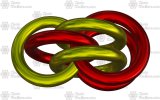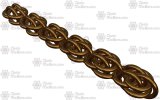What's the Difference?
The answer to the question of "What level of change to weave structure constitutes a new weave as opposed to a variant?" will vary depending on who you ask. However, it is indisputable that even minor changes in weave structure give you a weave that, while it may be similar to the root weave, is "different" from the original. Unfortunately, this often leads to confusion as to what has actually been woven. Each "What's the Difference?" article in the series will focus on a different set of similar and/or commonly confused weaves. There are many occasions where much of the confusion stems from the comparison of different images with the weaves being in multiple orientations and/or ring sizes. Renders made for the articles will be based upon similar AR's and orientation.
Renders of Fieldstone, Medo Persian and Sweetpea in this article are made with a wire diameter of 1.22 mm, an actual AR of 4.0, and are woven from left to right. The anchor ring in the following renders is the leftmost yellow ring.
Renders of Fieldstone, Medo Persian and Sweetpea in this article are made with a wire diameter of 1.22 mm, an actual AR of 4.0, and are woven from left to right. The anchor ring in the following renders is the leftmost yellow ring.
Fieldstone, Medo Persian, Sweetpea
In this first article, we will be focusing on the following trio of weaves:
- Top - Fieldstone
- Middle - Medo-Persian
- Bottom - Sweetpea
Cellular Structure
Important Note: Cell nomenclature and definitions (root cell, terminated cell, base cell, weave cell) have not been finalized at this time and may be changed.
Weave Cells
Weave cells are groupings of rings and/or cells that can be directly translated to continue a weave. Minor changes in weave cell configuration and orientation between cells can give a widely differing results.
- Top - Fieldstone weave cell
- Middle - Medo-Persian weave cell
- Bottom - Sweetpea weave cell
Cellular Connections
In addition to the configuration and orientation of weave cells, how those weave cells are connected to each other can also have major implications as to what weave you will wind up with.- Top - Fieldstone - Single connection between weave cells. Yellow single is connected to Yellow pair of the previous cell.
- Middle - Medo Persian - Dual connections between weave cells. Yellow single is connected to Yellow pair and Red single is connected to Red pair of the previous cell.
- Bottom - Sweetpea - Single connection between weave cells. Yellow single is connected to Red single of the previous cell.
With those weave cells and making those connections, you get the following:
Top - Fieldstone, Middle - Medo Persian, Bottom - Sweetpea
Conclusion
The differences in weave cell structure and the connections between the weave cells are what make these weaves structurally distinct from each other. That these weave cells are all made of centrally connected terminated cells are certainly a factor in their similarities.Appendix
Fieldstone:
Weave Cell:
Chain:

Related Weaves:
The following weaves start with the same weave cell as Fieldstone, however how they are connected to each other differ.

- One and a Half Persian (Top) is a contraction of 2 Fieldstone cells.
- One Hour Less Sleep (Middle) is a variant of One and a Half Persian (which also makes it a contraction of Fieldstone). In One Hour Less Sleep, the single rings are stacked.
- Undescribed? (Bottom) I'm currently researching this one to see if it's been described previously. It is a 90 degree rotation of the Fieldstone cell before being attached to the previous cell.
Medo-Persian:
Weave Cell:
Chain:

Related Weaves:
The following weaves start with the same weave cell as Medo-Persian, however how they are connected to each other differ.

- One Hour Less Sleep (Backwards) (Top) is a variant to Medo-Persian as One Hour Less Sleep is to One and a Half Persian. However, 1HLSB is NOT a contraction of Medo Persian.
- Gemini (Bottom) is a 90 degree rotation of the Medo-Persian cell before being attached to the previous cell.
Sweetpea:
Weave Cell:
Chain:

Related Weaves:
The following weaves start with the same weave cell as Sweetpea, however how they are connected to each other differ.

- Soyuz (Top) is a contraction of 2 Sweetpea cells.
- Mars (Bottom) is a mirrored tethering of 2 Sweetpea cells. This mirrored tether forces a 90 degree rotation between the cells.
Important Note: The related weaves mentioned above are not a comprehensive list, but merely a sampling.
Cellular Chainmaille Theory - CCT
Cellular Chainmaille Theory (CCT for short) is something that we're working on here at chainmaillers.com. It is currently a work in progress. Cell types and forms used in this article are based upon our current findings. We hope to be able to share more information with you regarding CCT in the future.Author's note:
It is our intent that these articles be living documents where additional information, corrections to any errors, and improvements will be incorporated over time. We encourage any discussion, insights, suggestions, or corrective criticism you may have on the subject presented in this article. This can be done by clicking the "Join the Discussion" button.
If you found this article useful or informative, please leave a rating.
